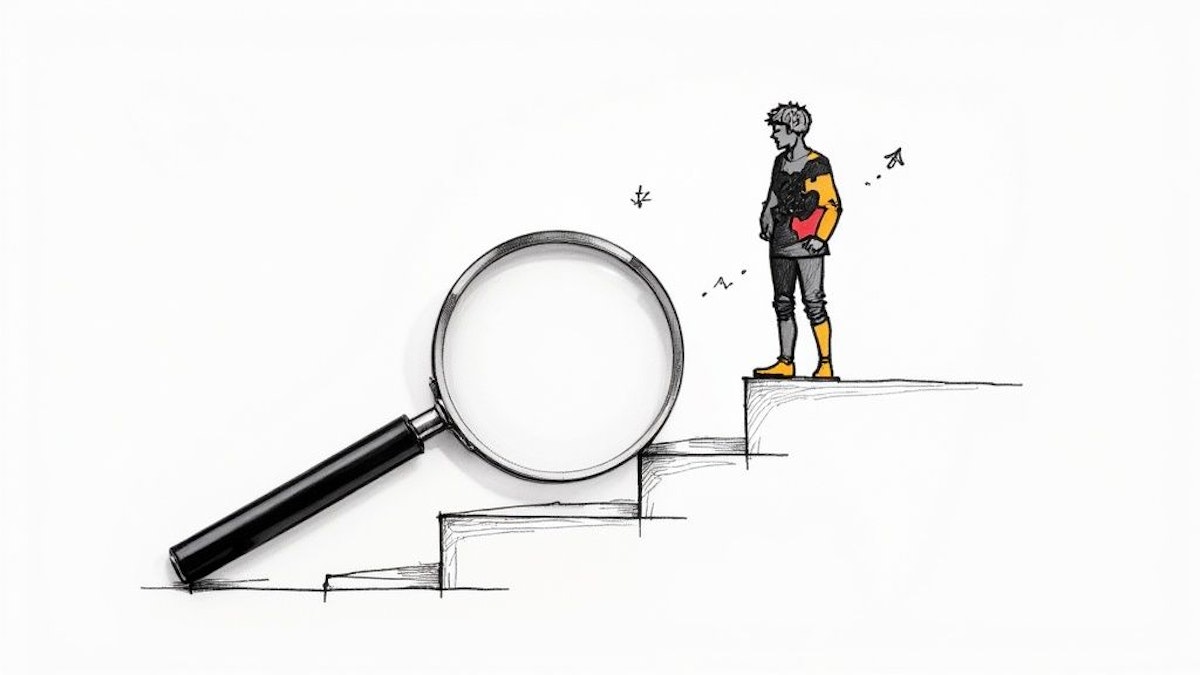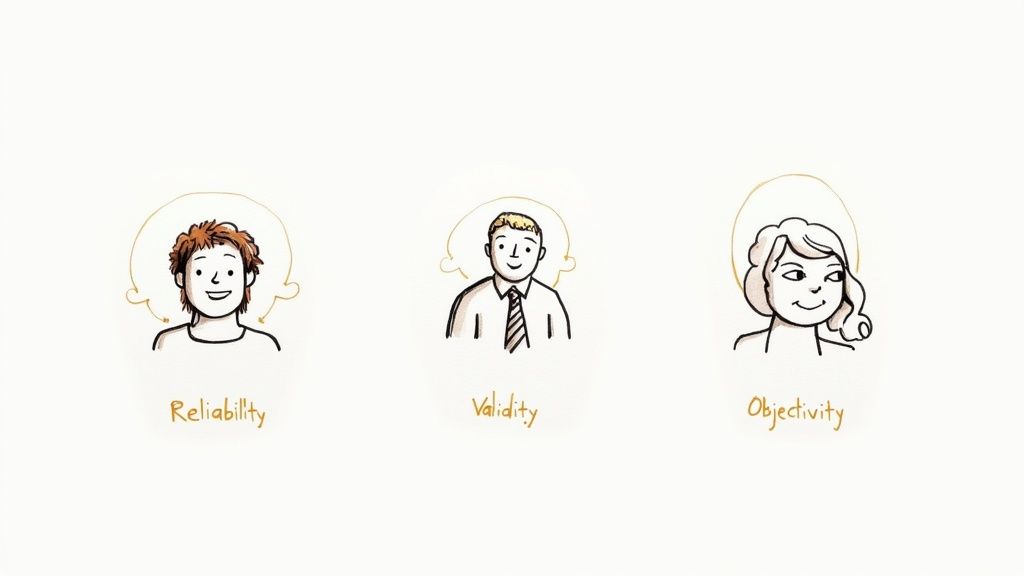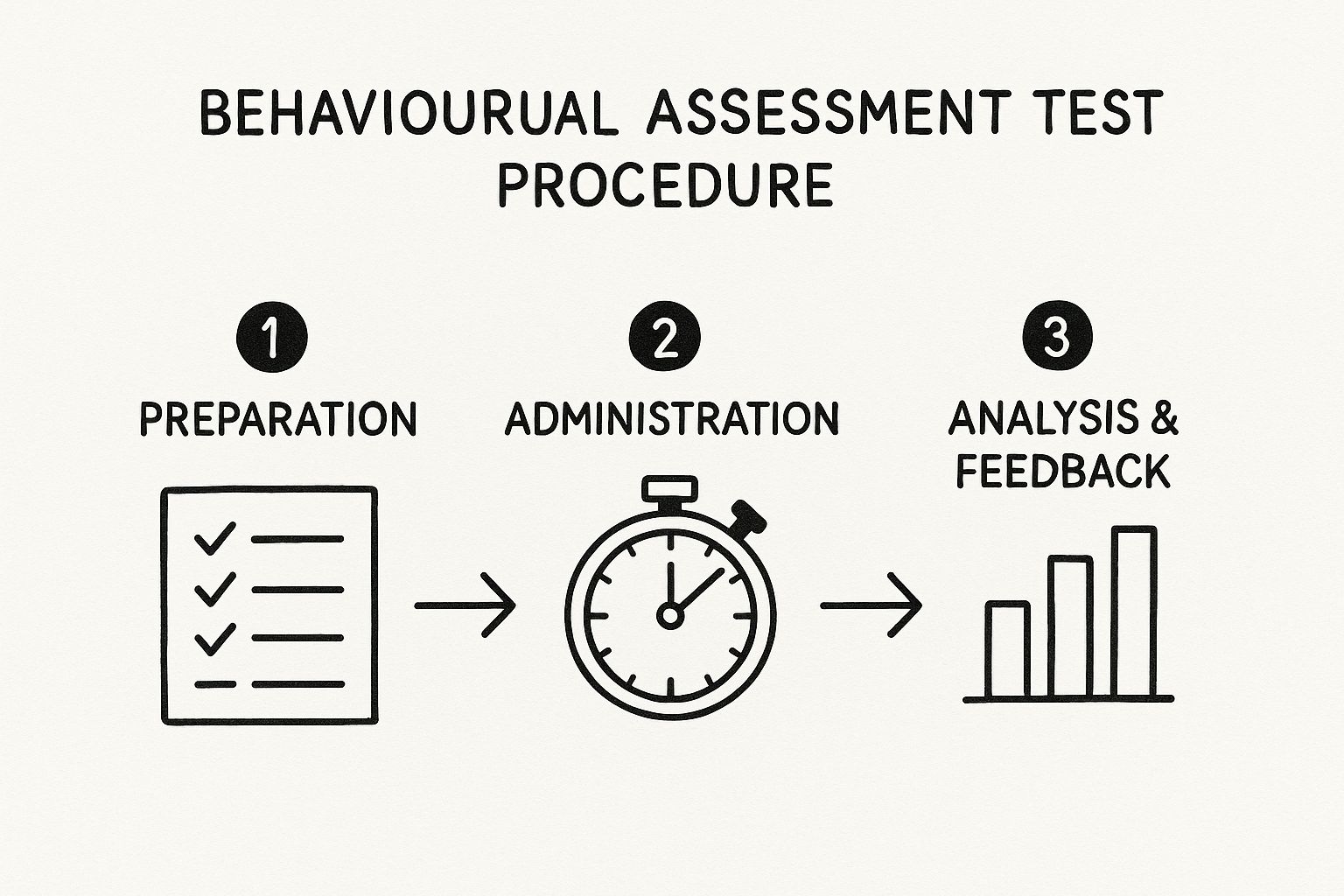Using a Behavioural Assessment Test to Hire Smarter

Ever wonder how someone really operates at work? A resume tells you what they've done, but it can't tell you how they'll handle a tight deadline, collaborate with a difficult colleague, or bounce back from a setback.
That's where a behavioural assessment test comes in. It’s a tool designed to look past the CV and get a glimpse into a candidate's natural workplace tendencies. It reveals how they think, communicate, and solve problems in their day-to-day work.
What Exactly Is a Behavioural Assessment Test?

Imagine trying to build a championship sports team just by looking at players' stats. You might assemble a group of individual all-stars, but you have no idea if they'll actually work together on the court. That's what hiring based on a resume alone is like.
A behavioural assessment is your scouting report. It shows you the intangibles—how a candidate communicates, their go-to method for tackling problems, and how they respond under pressure. It's not a pass/fail test; there are no "right" or "wrong" answers. The goal is simply to understand someone's default settings.
Going Beyond the Resume
Let's be honest, interviews can be subjective. We all have biases. Behavioural assessments add a layer of objective, structured data to the hiring process, giving you a much fuller picture of who you're considering.
They measure observable behaviours and help predict how a person is likely to act in real-world work scenarios. This highlights their strengths and pinpoints areas where they might need more support.
This data-first approach is catching on fast. The global market for these kinds of tests was valued at $6.5 billion in 2023 and is expected to nearly double, reaching almost $12.5 billion by 2032. This explosive growth, detailed in this psychometric tests market report, shows a major shift toward more evidence-based hiring.
To get a clearer idea of what these tests actually look at, here are some of the core dimensions they typically measure.
Key Dimensions Measured in Behavioural Assessments
| Dimension | What It Measures | Example Workplace Application |
|---|---|---|
| Communication Style | A person's natural approach to sharing information and interacting with others (e.g., direct, diplomatic, analytical). | A sales role might require a direct and persuasive communicator, while a research role benefits from a more analytical style. |
| Problem-Solving | How an individual analyzes information, makes decisions, and approaches challenges (e.g., methodical, creative, intuitive). | When hiring a project manager, you’d look for someone with a structured, methodical approach to solving complex issues. |
| Adaptability | The ability to adjust to change, handle unexpected situations, and remain resilient under pressure. | In a fast-paced startup, high adaptability is critical for navigating shifting priorities and ambiguity. |
| Interpersonal Skills | How a person builds relationships, collaborates with team members, and navigates social dynamics. | Strong interpersonal skills are essential for team leads who need to foster a positive and collaborative environment. |
| Work Ethic & Motivation | The internal drivers that influence a person's level of effort, persistence, and commitment to their work. | Understanding if a candidate is motivated by autonomy, recognition, or teamwork helps ensure the role is a good fit. |
These dimensions provide the building blocks for understanding how a candidate will not just perform tasks, but also contribute to the team and the broader company culture.
The Core Purpose of Behavioural Assessments
At the end of the day, the goal is simple: to make sure a person’s innate behaviours line up with what the job and the company culture demand. Get this right, and you’ll see some huge benefits.
- Improve Hiring Accuracy: You start making decisions based on solid data, not just a gut feeling from an interview.
- Enhance Culture Fit: You can spot candidates whose work styles and values naturally align with your team's.
- Boost Long-Term Success: People who are a good behavioural fit are far more likely to be engaged, productive, and stick around.
Think of it as a "workplace personality preview." These assessments help you build a complete profile of each candidate, making sure you find someone who won’t just do the job well, but will actually thrive in your organization.
Getting a handle on these tools is the first step toward smarter, more strategic hiring. For a deeper dive into the wider world of these tests, check out our guide on what psychometric assessments are.
The Science of Predicting Job Performance

A well-designed behavioural assessment is much more than a simple personality quiz. Think of it as a weather forecast for on-the-job performance. While no forecast is ever perfect, it uses proven models to give you a data-backed probability of future success—a far more reliable approach than relying on a gut feeling from an interview.
The backbone of many of these assessments is a framework called the Big Five personality traits. This model, backed by decades of research in organizational psychology, suggests that much of our personality can be understood through five core dimensions: Openness, Conscientiousness, Extraversion, Agreeableness, and Neuroticism (often remembered by the acronym OCEAN).
These aren't just abstract ideas; they have a real, measurable impact on how people behave at work. To fully appreciate this, it's helpful to understand how cognitive biases can influence assessment design and interpretation.
From Traits to On-the-Job Actions
So, how does this translate to the real world? Let’s take the trait of conscientiousness. Research has consistently shown that this trait, which measures organization, dependability, and responsibility, is one of the strongest predictors of overall job performance across virtually all roles (Barrick, M. R., & Mount, M. K., 1991, Personnel Psychology). A candidate with a high score here is very likely to be reliable, thorough, and detail-oriented.
Other traits are just as telling when matched with the right job requirements:
- High Extraversion: A strong indicator of potential success in roles that demand frequent social interaction, like sales or customer service.
- High Agreeableness: Often points to someone who will be a great team player and thrive in cooperative environments.
- High Openness: Suggests a creative and adaptable mindset, which is invaluable in fast-moving or innovative companies.
By measuring these stable traits, a behavioural assessment creates a clear link between psychological theory and tangible workplace outcomes. It turns personality data into a practical forecast of how a person is likely to act and contribute to your team.
The Power of Predictive Validity
This ability to forecast future performance is known as predictive validity, and it's the scientific gold standard for any hiring tool. A meta-analysis published in the Journal of Applied Psychology found that structured interviews and cognitive ability tests were among the most effective predictors of job success, far outperforming unstructured interviews, reference checks, and even years of experience (Schmidt, F. L., & Hunter, J. E., 1998).
An unstructured interview is notoriously prone to "first impression" bias, where a hiring manager forms an opinion in the first few minutes. An assessment provides objective data that acts as a counterbalance, pushing for a more evidence-based decision.
This data-driven approach doesn't eliminate human judgment; it enhances it. It gives managers objective insights, helping them look past surface-level impressions to see the core drivers of a candidate's potential. To dive deeper into this critical concept, check out our guide on the importance of validity in assessments.
Ultimately, this scientific foundation is what builds trust in a hiring process that is both fair and incredibly effective.
Exploring Different Types of Behavioural Assessments

Behavioural assessments aren't a one-size-fits-all solution. Think of it like a carpenter’s toolbox—you wouldn't use a sledgehammer to drive a finishing nail. In the same way, hiring managers have a variety of assessments to choose from, each designed to measure specific traits and skills.
Getting familiar with the different formats is key to picking the right one. Each offers a unique window into how a candidate is likely to act on the job, helping you gather the most relevant information for any role, from an entry-level assistant to a senior leader.
Personality Assessments
When most people think of behavioural tests, personality assessments are what come to mind. These are the tools that map out a candidate's enduring personal traits—things like how outgoing, detail-oriented, or agreeable they tend to be. They often use established frameworks like the Big Five or DiSC to build this picture.
From a candidate's perspective, it’s usually a straightforward questionnaire about their preferences and gut reactions. For you, the results are a powerful predictor of long-term behavioural patterns. A high score in conscientiousness, for example, is a strong signal that you're looking at a dependable and organised individual.
The value here is undeniable. In fact, a report by MarketsandMarkets projects the global talent assessment market to grow from USD 8.1 billion in 2023 to USD 13.5 billion by 2028. This shows just how much businesses are relying on them to build better teams and find the right leaders.
Situational Judgement Tests
Ever wanted to give a candidate a test drive before hiring them? That's essentially what a Situational Judgement Test (SJT) does. It's the flight simulator for the corporate world.
These assessments present applicants with realistic, tricky workplace scenarios they're likely to encounter. Then, they're asked to pick the best and worst ways to handle the situation from a list of options.
SJTs are fantastic for gauging practical problem-solving skills in a context that’s directly relevant to the job. It's not just theory; you get to see their judgement and interpersonal skills in action. This makes them especially useful for customer-facing and management positions where thinking on your feet is a must.
What makes SJTs so effective is their focus on applied behaviour. They go beyond asking "what would you do?" to reveal how a candidate's real-world judgement stacks up against the core competencies needed for success.
Emotional Intelligence Assessments
Emotional intelligence (EQ) is all about how well someone can recognise and manage their own emotions—and those of others. An EQ assessment digs into critical soft skills like self-awareness, empathy, and relationship management, which are notoriously tough to measure in a standard interview.
Candidates are typically asked how they would respond to emotionally charged situations. Their answers provide a clear look at their potential to collaborate effectively, lead with empathy, and navigate workplace stress without causing friction. While focusing on behaviour, it's also helpful to understand related tools like cognitive assessments that measure different aptitudes.
Each of these assessment types gives you a different piece of the puzzle. The real secret is matching the right assessment to the core demands of the role you're trying to fill.
How Behavioural Tests Pay Off for Your Business
Adding a behavioural assessment test to your hiring process isn't just another box to check. It's a strategic investment that delivers real, measurable results. When you look past the resume and interview performance, you get objective data that directly impacts your bottom line—from slashing the high cost of bad hires to building a team that actually wants to stick around.
These assessments give you a consistent, data-backed way to look at every single candidate. That's a huge deal for fair hiring. Interviews are notoriously susceptible to unconscious bias, but hard data helps level the playing field. It ensures you're making decisions based on traits that genuinely matter for the job, not just a gut feeling. To dig deeper, you can explore how to reduce hiring bias with an evidence-based approach.
Better Hires, Better Retention
One of the biggest wins you'll see is a major jump in the quality of people you bring on board. A behavioural assessment helps you spot candidates whose natural working style is a perfect match for the role's demands. This means they get up to speed faster and perform better, sooner.
It’s simple: when people are in jobs that fit their natural strengths, they're more engaged and motivated. That powerful alignment is the secret sauce for keeping your best people.
Think about the cost of getting it wrong. The U.S. Department of Labor has estimated that a bad hire can cost a company 30% of that employee's first-year earnings. Behavioural tests are your best defense against that kind of expensive mistake.
By focusing on a great fit from the very beginning, you build a more stable, committed team. You're not just filling a seat; you're investing in long-term success, which cuts down on the endless cycle of recruiting and training replacements.
Building Teams That Just Click
This isn't just about individual performance. The insights you gain from behavioural data help you build teams that are greater than the sum of their parts. When you understand how different communication styles and problem-solving approaches will mesh, you can assemble teams where people complement each other's strengths instead of clashing.
This insight fosters a much more collaborative and positive workplace. Communication flows better, and conflicts are easier to navigate because there's a shared understanding of how everyone operates.
In the end, it all adds up to tangible business wins:
- Lower Turnover Costs: Better hires mean you spend far less money and effort replacing people who weren't the right fit.
- Higher Productivity: People who are a natural fit for their roles are simply more effective and contribute more to the company's goals.
- A More Diverse Workforce: Objective data helps sidestep personal biases, leading to more diverse teams that bring fresh perspectives.
Simply put, these tools give you the data you need to build a stronger, more resilient, and more productive organization from the ground up.
How to Implement Your Assessment Strategy
Putting a behavioural assessment to work isn't as simple as picking a tool off the shelf and hitting "send." To get real value—the kind that leads to smarter hires—you need a clear, repeatable plan. It’s all about moving from a generic, one-size-fits-all approach to something targeted to what your company actually needs.
The first step, before you even look at a single test, is to build a success profile for each role. You have to clearly define what "great" looks like. What are the non-negotiable behaviours and traits someone needs not just to do the job, but to thrive on your team?
Define Your Ideal Candidate Profile
Go deeper than the standard job description. Sit down with your hiring managers and, more importantly, with your current top performers in that role. What makes them so good at what they do? Is it their incredible adaptability in a chaotic project, or their rock-solid conscientiousness in a role that demands precision?
You're essentially breaking the job down into its core behavioural parts. For instance:
- For a Sales Role: You’d likely be looking for traits like assertiveness, resilience when facing rejection, and a knack for persuasive communication.
- For a Software Developer Role: The focus might be completely different. Here, you’d probably want to see strong analytical problem-solving, meticulous attention to detail, and the ability to collaborate effectively in a team.
Once you’ve built this detailed profile, you have a solid benchmark. It turns a subjective process into something far more objective and focused.
Choose and Integrate the Right Assessment
With your success profile in hand, the next step is finding a test that actually measures those specific traits. They aren't all the same. Look for scientifically validated tools that give you reports that are clear and, most importantly, actionable.
Then, you need to figure out where it fits into your hiring process. The sweet spot is usually after the initial resume screen but before you invest hours in interviews. This way, you’re spending your valuable time with candidates who already show a strong behavioural alignment from the get-go.
This process flow shows how these stages connect, moving from the initial setup all the way to the final analysis.

As you can see, a successful strategy is a structured, multi-step process, not just a single action.
Train Managers and Uphold Legal Standards
A report full of data is useless if no one knows how to read it. It’s absolutely critical to train your hiring managers. They need to understand how to interpret the results, use them to ask better, more insightful interview questions, and avoid letting their own biases creep in. The goal here is to use the data as a conversation starter, not a final verdict.
Finally, you can't ignore the legal and ethical side of things. As of 2025, the use of these assessments is closely watched under data privacy laws like GDPR. These regulations dictate exactly how candidate data must be collected, stored, and used. While this has pushed assessment providers to build more secure and compliant platforms, the ultimate responsibility is on you to ensure the process is fair and that you’re protecting candidate information. If you want to dig deeper into this, you can learn more about the impact of data regulations on testing platforms.
A Key Takeaway: The assessment is just one piece of the puzzle. It should complement—not replace—other essential hiring tools like structured interviews, work samples, and reference checks to build a complete picture of each candidate.
Common Questions About Behavioural Assessments
Even when you see the value, bringing behavioural assessments into your hiring process for the first time can feel a little uncertain. It’s completely normal to have questions. Getting those questions answered is the best way to feel confident you're using these tools effectively and making a real impact.
Let’s dig into some of the most common things hiring managers ask when they start exploring behavioural tests.
Can Candidates Fake a Behavioural Assessment?
This is probably the number one concern we hear, and for good reason. You’re wondering if someone can just tell you what you want to hear.
While a candidate can certainly try, a well-designed modern assessment has a few tricks up its sleeve. Many have built-in validity scales that can spot when someone is answering inconsistently or just picking the "nice" answer every time. These flags tell you the results might not be a true reflection of the person.
But here’s the more important point: these tests don’t really have "right" or "wrong" answers. They’re designed to uncover a person's natural, ingrained behavioural style. If someone manages to fake their way into a job, they'll likely end up in a role that’s a terrible fit for who they really are. That mismatch is a fast track to them feeling disengaged, unhappy, and ultimately, not performing well.
The best approach is to be upfront with candidates. Let them know the goal is to find a role where their natural strengths will shine, not to catch them in a "gotcha" moment. Honesty helps everyone win.
Are Behavioural Assessments Actually Fair and Unbiased?
When they are chosen carefully and used correctly, behavioural assessments are one of the most powerful tools you have for reducing hiring bias, not adding to it.
Let's face it, human judgment is messy. We all have unconscious biases that can sneak into our decisions, whether it's favoring someone who went to the same college or has a similar communication style. An assessment cuts through that noise by providing objective, standardized data for every single person who applies.
It levels the playing field, making sure your decisions are grounded in job-relevant traits, not just a gut feeling from a first impression.
To make sure you're keeping things fair, always:
- Pick a scientifically validated tool. Go with a reputable provider that has tested their assessments for fairness across different demographic groups.
- Use it as one piece of the puzzle. The results should inform your decision, not make it for you. It's just one data point among many.
- Be consistent. If you use an assessment for a role, give it to every candidate for that role. No exceptions.
How Should We Use the Results in an Interview?
The results shouldn't be a pass/fail gate. That’s a huge missed opportunity. The real magic happens when you use the assessment report as your secret weapon to supercharge your interview. Think of it as a personalized road map for your conversation.
Instead of lobbing generic questions over the plate, you can now ask incredibly targeted, behavioural ones. For example, say the assessment shows a candidate is a fantastic collaborator but might be less assertive. You could ask:
"Tell me about a time you were on a team project and you disagreed with where things were headed. What did you do, and how did it turn out?"
This kind of question helps you see how their natural tendencies actually play out in real-world scenarios. It brings the data to life and gives you a much richer understanding of who you’re talking to.
What's the Typical Cost of These Assessments?
The price tag on behavioural assessments can vary quite a bit. It really depends on the provider, how in-depth the test is, and how many people you plan to assess.
Some providers use a pay-per-test model, which could be anywhere from $20 to over $200 per candidate. If you hire frequently, a subscription model is usually much more cost-effective, giving you unlimited assessments for a set annual fee.
While it’s an upfront investment, the return you get is huge. A 2022 Gallup report found that businesses with highly engaged employees see 23% greater profitability. By helping you hire people who are a natural fit for their roles—a key driver of engagement—assessments provide a strong ROI. Preventing just one hiring mistake can pay for your entire assessment program, sometimes several times over. The real ROI shows up in better retention, higher productivity, and teams that just work better together.
Ready to build a stronger, more aligned team with data-driven insights? MyCulture.ai provides science-backed assessments that help you identify candidates who will truly thrive in your unique culture. Start making smarter hiring decisions today.